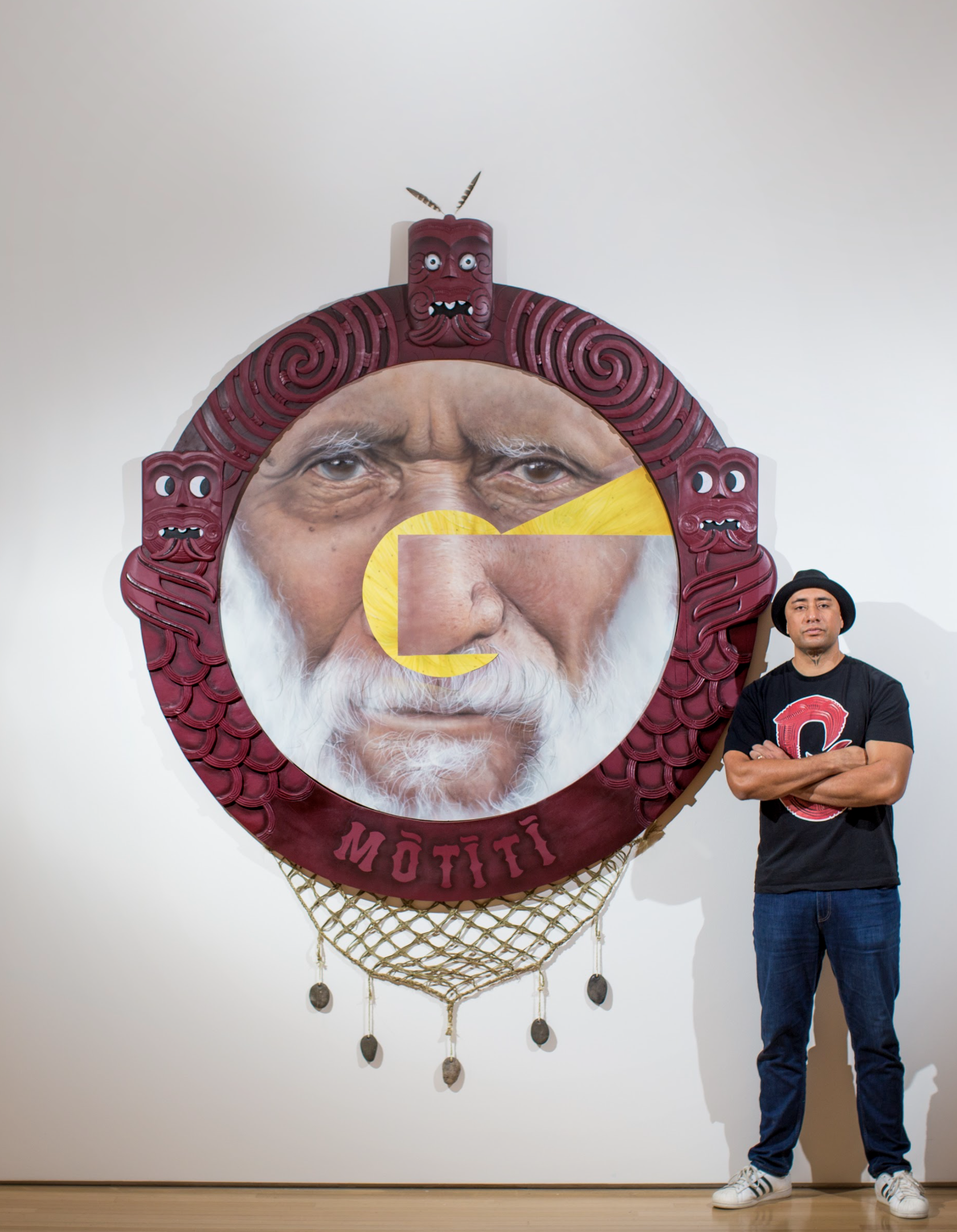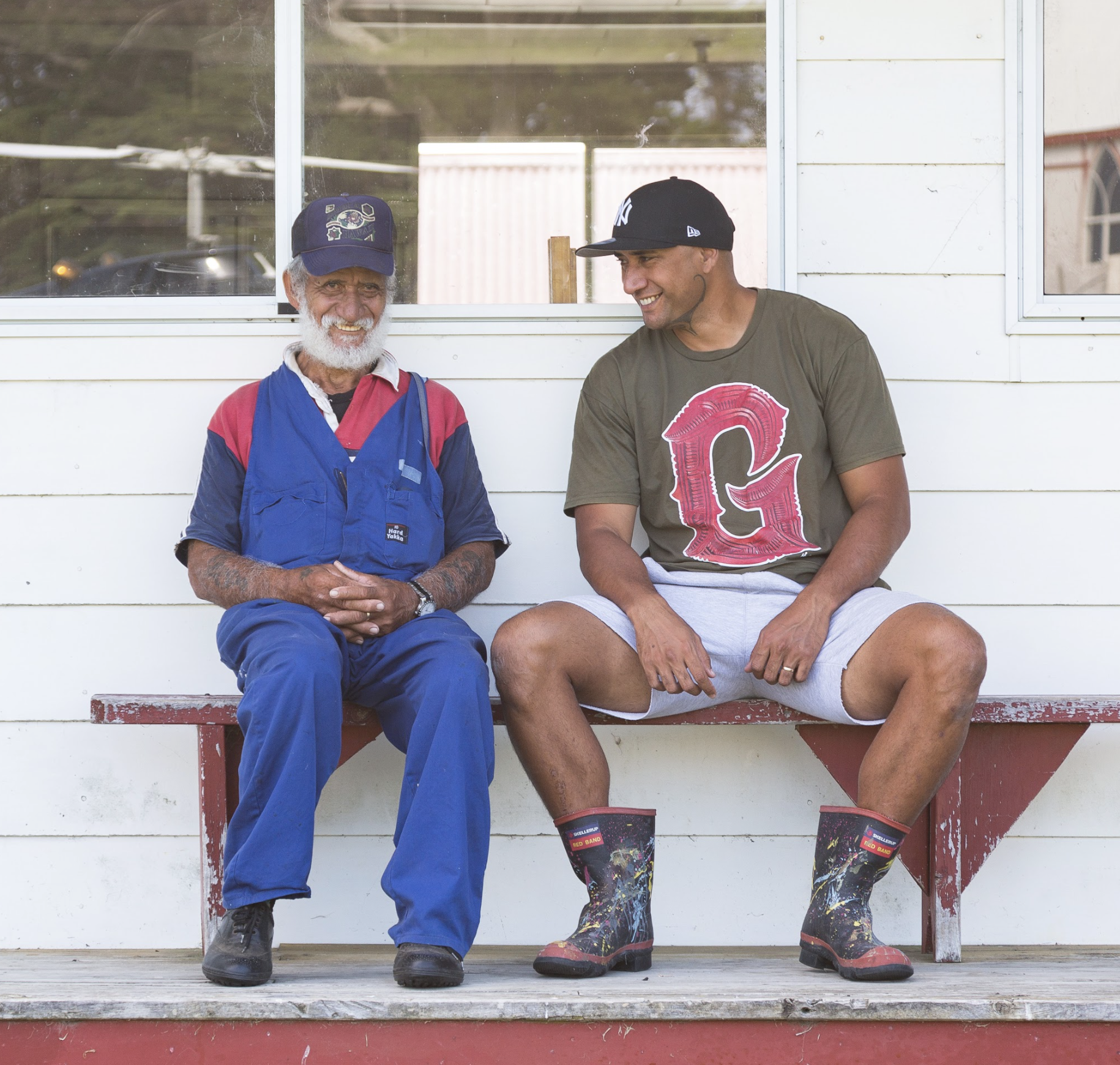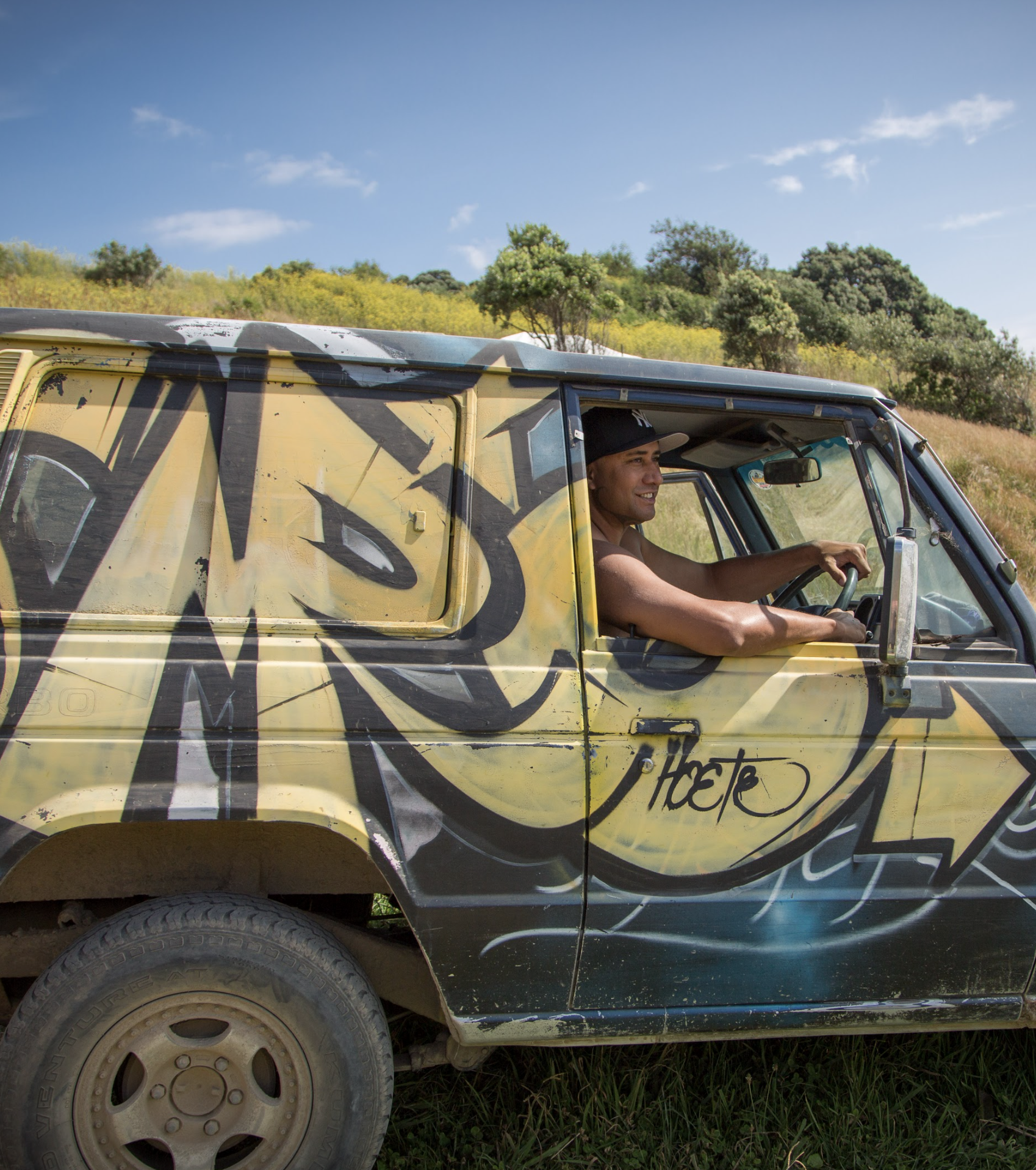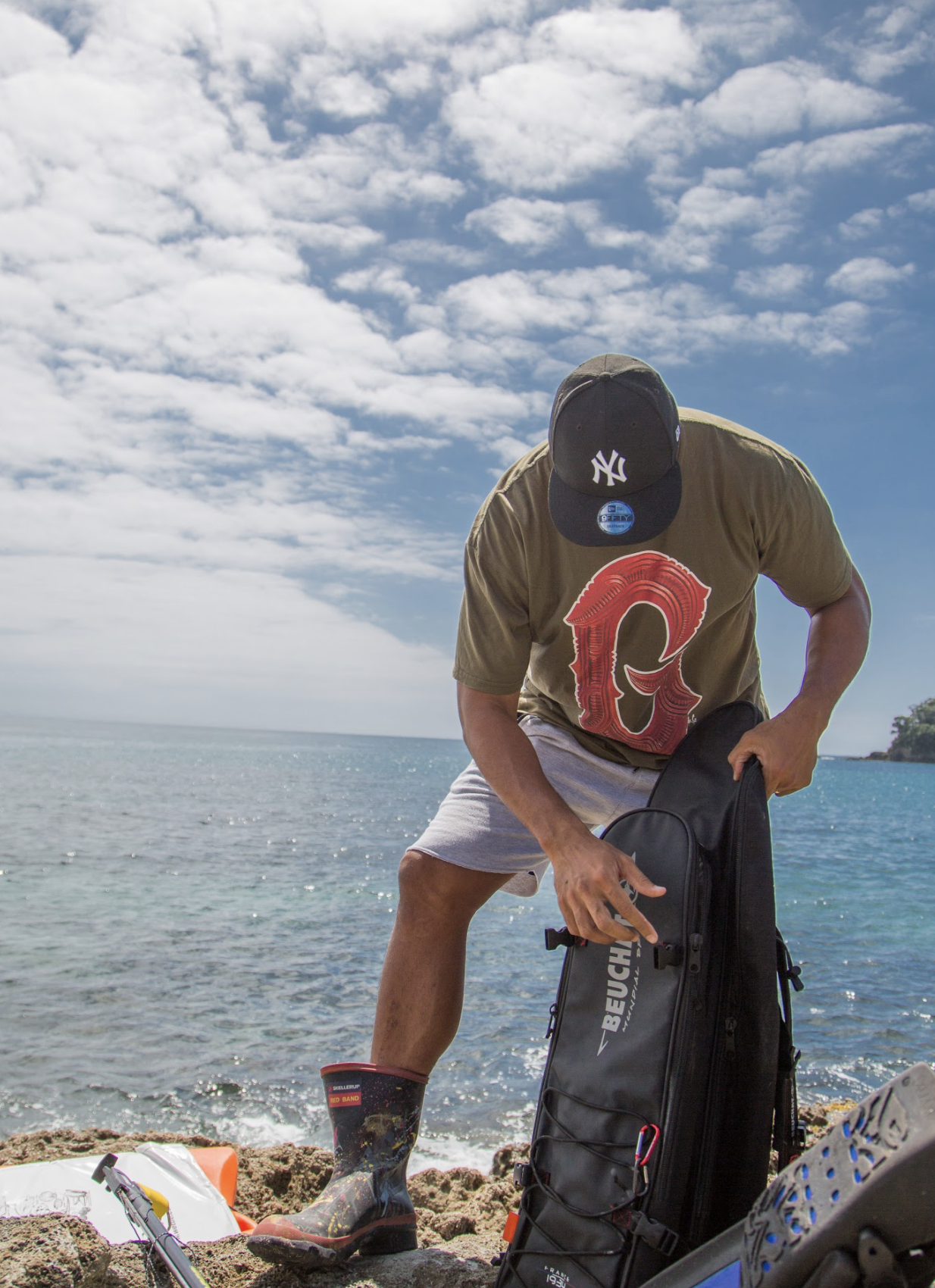Mr G: capturing and connecting with whakapapa through art
With his large-scale portraiture work proliferating around the globe, UNO discovers that it’s Graham Hoete’s deep connection to home that gives this artist’s pieces a depth that extends far beyond their physical size.
WORDS JENNY RUDD / PHOTOS QUINN O'CONNELL
"Let me talk you through this portrait of my dad," says Mr G, showing me a photo on his phone. I'm having dinner with UNO publisher Mat and artist Graham Hoete, “Mr G”, in Izakai at Bayfair in the Mount. There's quite a bit going on around us in the busy restaurant as they serve a five-course degustation but, at our table, all I can hear is Graham's euphonious voice as the future of Māori portraiture explains why hononga [connection] to the art he's creating has become his true north.
Graham is best known for his large-scale spray paint murals. I wonder how far afield his art can be found and discover a video online of him in an All Blacks shirt and a kilt, painting a mural of his ancestor, John Alfred Borrowdale Murray, onto a wall of the oldest building in the village of Moffat, Scotland, where John Alfred was born. "I wanted to pay tribute to my Scottish three-times great-grandfather on behalf of all the Murray whanau in Aotearoa who are descended from him," says Graham. If you keep looking online, you'll find more celebratory photos unveiling Mr G murals across the world, most of which are portraits.
His current artistic focus plays a film in my head, starting with Graham in front of huge crowds – like the one where he unveiled an eight-metre mural of Prince in Minnesota – running backwards to New Zealand, then Bay of Plenty, then finally to the tiny island of Mōtītī where he grew up and, before him, his father. Home.
Graham is putting together pieces for an exhibition called Home to be shown at Tauranga Art Gallery from November 9, 2019. Graham and photographer Quinn O'Connell flew to Mōtītī to take photos that show the importance of his hononga to home.
It's easy to underestimate the everyday things that are so precious to us. Quinn's photo of jars of preserved peaches sitting on a stove resonated with Graham. "To someone else, it's just fruit and glass but, in the context of my life, it's so much more. It's a symbol of home. I felt the deepest of hononga when I saw those peaches. And it won't last forever as, one day, my mum won't be here to make them, and someone else will be in this house, using this stove."
That takes us back to the portrait he's showing me on his phone. "I'm going to talk you through every aspect," he says. "You will see and feel something else when you understand the context."
"Portraiture isn't just about painting a face, it's about representing a person and all they are connected to."
Every element in the multidisciplinary portrait has some kind of hononga to Graham's father. Photorealism, spray-painting, whakairo [wood carving], sculpting, weaving, fabrication; each has its role in connecting Graham's dad to his past, his whakapapa [genealogy], whenua [land], and to the artist, his son.
"Portraiture isn't just about painting a face, it's about representing a person and all they are connected to." And in this, the first in the series, the artist is part of the story; the bloodline is the ultimate connection. The next day we meet in Graham's Papamoa studio, where I can see, touch and feel it all.
Capturing a father’s spirit
Graham's dad grew up on Mōtītī Island. The islanders grew maize and spent time in the ocean. "He's a hardy, gruff, old school kind of guy," says Graham. As the kaumātua at the marae, he introduces himself by saying,
Ka tangi te titi
Ka tangi te manu
Ko te manu ko te karoro
ko te karoro ko kere am e Hoete
"He's saying he's a black-backed seagull. The first time I heard him say these poetic and soulful words, I was blown away. It was true, too, as that's what we would have seen all the time while he was working in the fields or on the beach. And, when I see the birds from Papamoa where I live, I feel hononga to my Dad."
Painting the face
"I chose to spray-paint the face because it represents the hononga to my artistic journey. Using spray-paint to convey this level of detail isn't easy, and I really went steroids on the photorealism. It helped not having the time constraints that I usually have on a mural.
"Photorealism has an amazing ability to engage and attract people. It's universal. They always buzz out saying, 'Oh, it's so real, look at the lines on the face!' It draws everyone in, no matter their background. You then have their attention to look at the context of the image through the visual storytelling around the frame.
"It's not a traditional head-and-shoulders portrait. The face is pushed forward because I wanted to focus on his eyes, the most engaging component of a portrait. He's always had a great weathered, journeyed look which is well-suited to a portrait. I maximised every detail.
The yellow G
"In the centre of the portrait there's a yellow portion. That's a zoomed-in painting of the yellow pōhutukawa flower. These yellow trees were discovered on Mōtītī Island in 1814, and they are the symbol of the islanders who'll be reminded of home every time they see the bright flower. There are only two of the trees left on the island and one of them's outside my dad's house. The G symbol will continue throughout this portrait series."
The frame
The face has a beautiful aesthetic and spray-painting has a modern, edgy, street feel to it. That contemporary discipline has been fused with whakairo, the ancient art of Māori storytelling through wood carving. The frame tells the story of the central portrait. The wood is a blend of kauri and matai, and it's extremely heavy. It took three people to lift it onto the wall at the gallery for the photoshoot. The physical weight and density of the wood gives heft to its role in the portrait – to solidify and make tangible the histories and stories of Graham's father, his tribe, his home.
"I have always wanted to learn how to carve. I used to live with one of my uncles, he was a master carver in the traditional style. Its purpose is to tell each tribe who they are and show their cultural identity visually. The history of a tribe is told through carvings to future generations.
"About a year ago, I started to learn how to carve, and I'm lucky to be learning from one of the best Māori carvers in the world, Todd Couper. He's just a real Jedi when it comes to whakairo. I was walking up Papamoa Hills one day and he was walking down. He called out, ' Hey, Mr G!', and, from then on, we became friends. His work is exquisite. He's an exceptional perfectionist, and shows his work around the world. He lives in Papamoa, so we see each other most days.
The kupenga
Each marae has a theme which connects the local iwi, hapū and whanau to their ancestry and story. In Tamatea ki te Huatahi marae, which is the main marae on Mōtītī Island, the kupenga [fishing net] plays a central role in its interior storytelling. There are carvings on the pillars as you enter the marae and references throughout the buildings. The curved shapes on the bottom left and right of the frame echo the kupenga hanging below the fame.
“I feel very connected to my dad through his sea-venturing stories, especially through my own love of the moana."
"It shows the connection to the moana [sea] and that lifestyle. My mum and a few of my aunties still go diving for kina and pāua. It's not often you see groups of ladies my mum's age going diving! They are legends.
"There's strong hononga with this element of the portrait. The kupenga has been woven by my sister. She went and collected harakeke [flax] from Mōtītī, and the sinker stones are from Tumu Bay on the island too.
"When my dad was young he used to take me out diving. I loved watching him and my uncles spear fish with a Hawaiian sling. They were graceful, like the fish they swam after. As a young guy, I was inspired to watch them. Many people never get to go diving but, to them, it's second nature. Dad and Uncle Patu used to have competitions to see how many fish they could catch, as kids. They'd make their own spear guns out of poles and bits of rubber and spear blue maomao then thread them and trail them around as they fished. I feel very connected to my dad through his sea-venturing stories, especially through my own love of the moana."
The carved heads
As we move through the portrait, it's clear that the role of the sea is absolutely central to Graham's dad's life as an islander. The two faces on the left and right are based on the amo [posts] outside the marae.
At first glance, the eyes which look inwards at the portrait appear cartoonish. But Graham explains they've been painted to represent maramataka [the lunar cycle], and the waxing and waning crescents of the moon around which island life is based. The phases of the moon affect the tides, when to fish and when to plant crops. The economy and lifestyle of the island is centred around the moon. Mōtītī is so small, but all life upon it is driven by cycles way bigger than any of us.
The double tongues on the faces are common in Māori portraits. And there are various different meanings. Te Kau wae wai runga, Te Kau wae raro refers to the celestial and terrestrial language we use, but it can also refer to how you speak to people inside and outside the marae. Protocol is a big part of Māori culture, especially on the marae ātea [open area in front of the meeting house]. The two tongues can also represent division and deception. You'll often see the double-tongue depiction on maraes on the east coast in the Bay of Plenty, towards Whakatāne."
A closer look reveals many elements of traditional whakairo in the faces with their own inherent meanings. The little notches or taratara ā kae along the tongues represent food
and eating, and the pattern above the mouth is called pākati and is one of the main surface
patterns of whakairo.
"And at the top of the portrait is kōruru, which represents the main ancestor of his marae, Tamatea ki te huatahi. It's the same face that presides over our marae and is the symbol of our tribe and so it's fitting that he does the same job over the portrait of my dad."
The future
Learning about Graham's portrait has opened up discussions about how we relate to each others' cultures and what we can all do to stay respectful. And what's happening to Māori culture in its home, New Zealand, and how we can keep its roots watered and well.
Later this year, Graham and his wife Millie are travelling to Art Basel in Miami – one of the world's biggest and most prestigious exhibitions of modern and contemporary art – to see what place in the world his series of portraits could hold.
Graham believes his portraits are unique and are the future of Māori portraiture. "I respect the portraits that Goldie and Lindauer painted, but what I have that they didn't is direct hononga to the culture, so I feel that puts me in the best possible place to be Māori portrait artist of the future. I have a commision for a lady in Hamilton after she saw my father's [portrait]. My plan is to do more portraits of Māori, sourcing materials where they are from, and telling stories of hononga to their whakapapa and homeland."
When you go to the Home exhibition, you are now able to stand in front of this magnificent portrait and know the connection of this man to the life he has led.
Home Exhibition
Tauranga Art Gallery
9 November 2019 - 9 February 2020
hapū (ha-poo)
sub-tribe, clan a number of whanau (families) make up a hapu, usually from the same ancestor. A group of hapu make up an iwi.
harakeke (ha-ra-kee-kee)
flax
hononga (hoh-nung-uh)
connection
kaumātua (koe-mar-to-ah)
tribal elder
korero (koh-re-roo)
black-backed seagull
koruru (koh-roo-roo)
carved faced on gable at the marae
kupenga (koo-pen-nga)
fishing net
manu (ma-noo)
bird
marae (muh-rye)
meeting house
marae atea (muh-rye ah-tee-uh)
flat piece of land in front of the wharenui
maramataka (mah-ra-ma-ta-ka)
lunar calendar
moana (moh-ah-nah)
sea
takarangi (ta-ka-ran-gee)
the heavenly realm
taonga (tah-ong-ah)
possessions
whakairo (fuh-ky-roh)
Maori carving
whakapapa (fuh-kuh-papa)
genealogy
whanau (fah-noe)
family
wharenui (fa-re-noo-ee)
the main building at the marae
whenua (fen-ooa)
land









